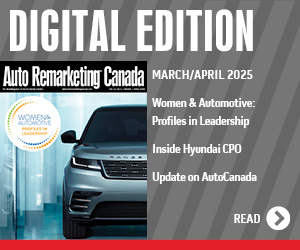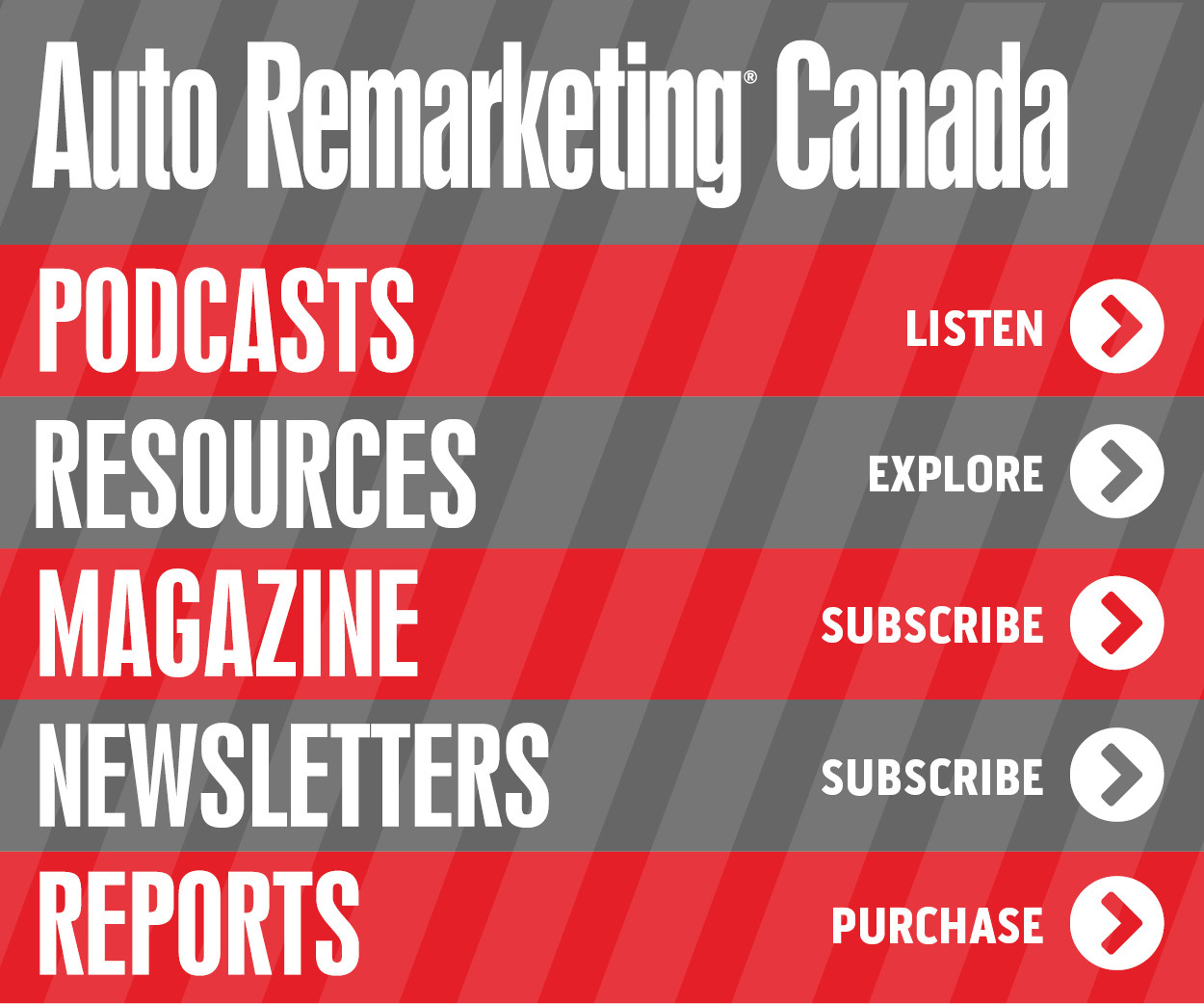Next generation of automotive leaders: Dealers talk recruiting, retaining & changing perspectives

[EDITOR'S NOTE: This story appears in Auto Remarketing Canada's Women & Automotive Profiles in Leadership issue. Reporting for and writing of this story was conducted prior to the COVID-19 pandemic's most severe impact on the auto market]
According to McKinsey & Company’s fifth Women in the Workplace study, published in 2019, there were a few “bright spots” in the overall environment when considering advancing women into senior levels in the workplace in recent years.
According to the report, one of those bright spots was representation of women at the C-suite level, which showed a 24% improvement over the five-year period study that started in 2014.
Granted, down from the C-suite, representation of women at the manager level dropped by 5%, and the representation of women of color fell by 5%, as well. Ultimately, women remain underrepresented “at every level,” McKinsey said, quoting statistics from its report that included findings from close to 600 companies.
The auto industry looks even more grim. According to the 20-First in Global Gender Scorecard, in 2018 there were 193 men and 16 women (up from 14 in 2014) in the top teams of the 20 leading automotive companies. These scorecards look at a simple core metric: the gender balance of the executive committees of top companies around the world.
All that to say, this leads us into a big question for today’s auto industry, in particular: Where is the next generation of auto leadership going to come from, and what is it going to look like? And what may be the keys to recruiting and retaining top talent for your auto retail business?
Auto dealerships, for example, are notoriously male-dominated. That reality, and the resulting negative stereotypes about the work environment, are still having to be addressed by the industry, the dealers quoted in this feature said.
However, these auto retail leaders contend there are ways to encourage diversity and inclusivity in the auto dealership, and in doing so, make sure you have the best auto retail team possible.
Addressing stereotypes, flexibility in the auto dealership
For many, the auto dealership is associated with commission-based sales. But there’s more to the dealership than long weekends, evening hours and commission-based pay structures. Think beyond the sales floor, to all of the other keys and cogs that make the auto dealership tick.
Sarah Budd, a 2019 Women & Automotive Profile in Leadership honoree and general manager of Budds’ Mazda, told Auto Remarketing Canada that it might take a change of perspective to attract more young people to the auto dealership career path.
“In auto, we are always so focused on the customer experience. It’s important to also focus on the employee experience. A happy team is more likely to deliver quality service to our customers,” said Budd. “Create a culture of open communication, fairness and teamwork, and you’re more likely to keep and attract better personnel.”
Another big concern for the auto dealership in particular: negative stereotypes, which fighting can often feel like an uphill battle.
Budd said: “I think the auto industry’s reputation has to change, and it is slowly,” but often, people still have a negative view of the car dealership, “and by association the people who work there.”
These views can hinder recruitment efforts, and are still likely to further shy women and others away from the auto retail industry as a career option.
“But the reality is that we’re not all just salesmen; we have those, too — and they’re generally nice people,” said Budd. “There are so many roles within a dealership — human resources, technicians, graphic designers, accountants, etc. We need to do a better job of getting the word out that there’s a role for every type of person with every type of talent.”
And that’s just it. In the dealership and beyond, there are often simply more jobs and more career paths within these industries and areas than those graduating high school and college may be aware.
Samantha Cunningham Zawilinski, vice president of account services at Potratz Advertising, said that for some of her agency’s dealer clients, it's a struggle when it comes to getting candidates to understand that working in a dealership can be much more than just a sales position.
Cunningham Zawilinski said that to address that dilemma, an employer must focus on more than just the job description for a position.
“When you have a school visit your dealership for a career fair, or you do something fun with your employees, make sure to post about it across your social media platforms, newsletters, etc. That is all part of your recruitment efforts,” says Cunningham Zawilinski.
Recruiting & retaining
So, does more need to be done in terms of presenting the auto dealership as a viable career option for young people entering the workforce, and for young women in particular?
Budd’s marketing team, for example, is already on the task. The team recently analyzed all of its job postings material in order to expand its candidate pool.
“We tended to just reuse the same templates over and over again,” Budd said. “We found that some of the language we used or the descriptions we gave, maybe didn’t reflect the modern dealership experience or the people we were trying to attract.”
The dealership is currently in the process of rewriting those postings to appeal to a broader audience of professionals, including women.
Cunningham Zawilinski reminded dealers not to forget their social media accounts when recruiting for their stores. She offered this example from a Potratz dealer client. A weekly video series implemented for the dealer included topics like, “What’s it like to work at the dealership?” or “How to buy a car.”
“And in creating transparency in all of these different topics, we actually found that we were having individuals reach out to this dealership and saying, ‘Hey, you know, are you guys hiring?’ she said. “Why? It’s because the content we’re putting out there is establishing this dealership is a trustworthy, fair dealership,” and potentially a great place to work.
Sharing content online establishes the dealership’s culture and shows potential job candidates the store is “more than just someplace to go to sell cars,” Cunningham Zawilinski said.
Another big potential turn-off to those searching through auto dealership listings at dealerships: previous auto experience.
“I think we also make the mistake of insisting on previous auto experience when we hire. Sure, you can’t have an entire team of people who are new to the industry,” Budd said. “But I think we would do well to take more chances on hires who bring a different set of experiences. Again, it’s all about how important mentorship is to this business.”
Laura Zanchin, a 2019 Profile in Leadership honoree and executive vice president and principal at Zanchin Automotive Group, said that to present the auto dealership as a viable career option for young people entering the workforce, especially women, “we have to start young.”
The Zanchin group actively communicates and recruits from institutions like the Automotive School of Canada — Georgian College, and is exploring visiting elementary and middle schools, as well.
“If we are going to change the image of the auto dealership as one, being male-dominated; and two, get rid of negative stereotypes, we (auto dealers) need to start talking and getting out there,” Zanchin said, adding it comes back to the “you can be it, if you can see it” mentality.
“This (auto dealership) is a great opportunity for women, and there’s such a big hole, and we want women to know the dealership is a great option for them and a great opportunity,” Zanchin said.
Debbie Butt, area parts and service manager at Toyota Canada, agrees with this approach. Butt said that “by reaching them in high school, before picking university/college, piques their interest in new and innovative technologies and shows them the many career paths that can be taken within the automotive industry.”
She noted that we must also “glamorize the trades,” and remove the stigmas often surrounding dealership or auto technician work.
“Society is constantly changing and is becoming more acceptable for women in the auto industry. With the drive with women wanting to prove that that they can do anything a man can do, they push themselves, we just have to show them growth for advancement, and it will give young people the drive to pursue a career in the automotive industry,” Butt said.
Andria Zanchin, also a 2019 Profile in Leadership honoree and fellow EVP and principal with sister Laura Zanchin at the Zanchin group, brought up an interesting point, especially when it comes to recruiting female talent to your dealership.
The issue might not always be that women don’t consider the auto retail industry as a viable employment opportunity, but rather the avoidance is often related to the fact that the hours are long and inflexible, and pay structure hyper-competitive and inconsistent.
Andria Zanchin said, “Unfortunately, we haven’t reached that general 50-50 male/female split when it comes to house and family work and raising children; so often, for women candidates in the dealership, things like working until 9 p.m., and weekends, are an impossibility.”
She said dealerships need to work to be more flexible and consider more options, in order to be more inclusive.
In the Zanchins’ experience, many candidates in auto dealership interviews freeze when asked this simple question: “What is your availability?”
“They’re afraid. They don’t want to say, ‘Yeah, I have to leave at five. I have to get my kid.’ But you know what, that’s reality, right?” Andria Zanchin said. “Ask and address the questions that maybe you don’t really want to ask; it’s better to ask them, and get it out in the open.”
And then, if it’s a standout candidate you want in your store, you’ll know what support, hours or options that potential employee will need.
Flexibility is key here, Cunningham Zawilinski agrees. And thankfully, in the digital age, there are increasingly more roles that don’t always have to be completed from the confines of any one physical location.
Of course, most dealerships still certainly need service technicians in the service bays and salespeople in physical showrooms, but there are jobs in the business development center, answering chat inquiries, and many more, that can be much more flexible when it comes to hours, and/or work location.
Consider onboarding
Once a candidate is chosen, another process that can be further honed to create a higher chance of success for that new employee is a comprehensive onboarding process.
Cunningham Zawilinski believes this is an area in which a lot of organizations can “strengthen.” Sticking to a process — just like one would in walking buyers through a sale — can set the new team member up for success.
These tactics can include mentorship programs, training calendars, a shadowing period and more. And are there solid expectations in the dealership set from day one? This is especially important if you are hiring from across industries, as the dealership and auto industry often come with a high learning curve.
“Because if somebody is making a career shift, how are you supporting that and making it attractive aside from maybe making it a lucrative shift?” Cunningham Zawilinski said. “How are we going to establish and create their success in our organization, because people don’t want to fail. So how can we make them feel like they’re going to succeed here, as well?”
As to how to retain these dealership employees once you find them, Laura Zanchin has two words: constant communication.
Andria Zanchin explains further: “I think to retain, it’s just all about the relationships that you have at the dealership level and the communication that you have with your staff, and making sure that the goals are set for them and the goals are clear, because nobody likes to feel like they don’t have something to aspire to or something to work towards.”


